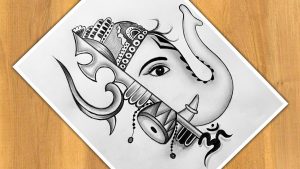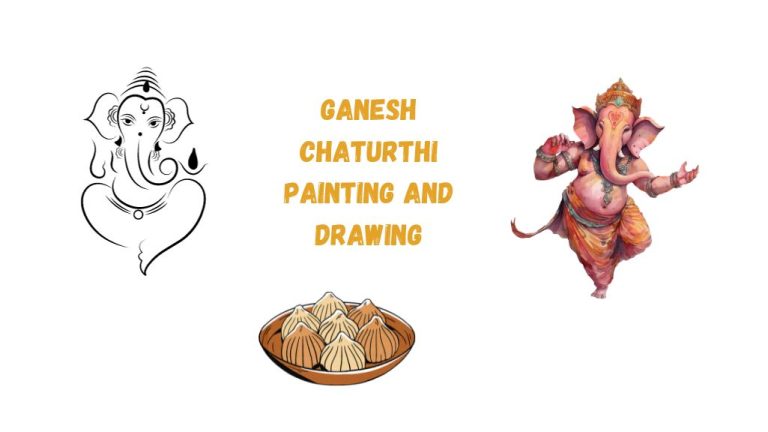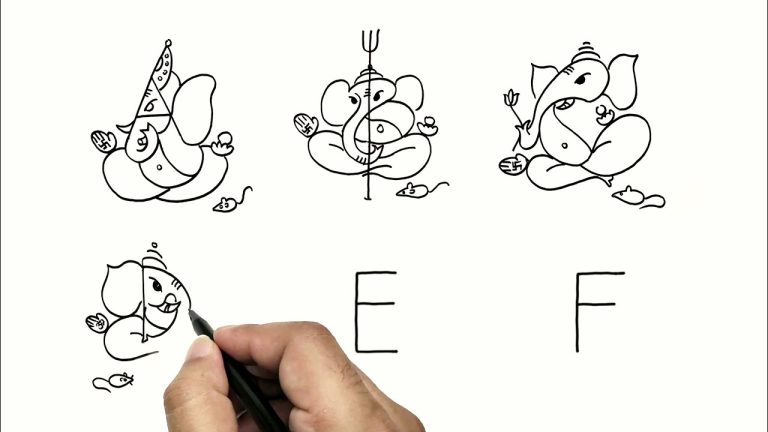Creating a Ganesh drawing is a beautiful artistic endeavor that pays homage to the revered Hindu deity, Lord Ganesha. Start by outlining the distinctive features, such as the elephant head, symbolic of wisdom and intelligence. Emphasize the large ears, representing the importance of listening, and the broken tusk, symbolizing sacrifice. Depict Lord Ganesha’s four arms, each holding symbolic objects like the goad
- Mastering Ganesh Drawings for Beginners
- Drawing Lord Ganesha with Reverence
- The Spiritual Essence of Ganesh Drawings
- Exploring Variations in Artistic Depictions
- Creating 3D Ganesh Drawings
- Dynamic Poses and Expressions in Art
- Choosing Colors with Spiritual Significance
- Frequently Asked Questions (FAQs)

Mastering Ganesh Drawings for Beginners
Ganesh, the elephant-headed deity of wisdom and prosperity, is a popular subject for artists of all levels. But for beginners, capturing his intricate details and divine essence can seem daunting. Fear not, young artist! With a few simple steps and a dash of dedication, you can master the art of drawing Ganesh and bring his blessings to life on your canvas.
Laying the Foundation:
- Start with the Basics: Begin by sketching light, basic shapes like circles and ovals to represent Ganesh’s head, body, and limbs. Don’t worry about perfection at this stage; focus on capturing the overall proportions.
- Anatomy and Proportions: Reference images of Ganesh to understand his unique anatomy. Pay attention to the size and placement of his head, ears, trunk, and tusks. Remember, his head is typically larger than his body, and his belly is often rounded and protruding.
- Sketching the Details: Once the basic shapes are in place, gradually add details like the eyes, eyebrows, and mouth. Use gentle curves for his eyes and a curved line for his smile. Don’t forget the distinctive curve of his trunk and the details on his crown.
Bringing Ganesh to Life:
- The Power of Lines: Use confident strokes to define Ganesh’s features and add texture to his skin. Vary the thickness of your lines to create depth and dimension. Remember, lighter lines for the delicate features and bolder lines for the prominent ones.
- Embracing the Symbols: Ganesh is often depicted with symbolic objects like the axe, lotus flower, and mouse. These elements add meaning and depth to your drawing. Remember, the axe represents power and overcoming obstacles, the lotus flower signifies purity and knowledge, and the mouse symbolizes intelligence and overcoming limitations.
- Adding the Divine Touch: Don’t forget the subtle details that add a touch of divinity to your Ganesh. Draw a halo around his head, add small bells on his ankles, and decorate his crown with jewels. These elements enhance his divine aura and make your drawing truly special.

Drawing Lord Ganesha with Reverence
Drawing Lord Ganesha with reverence requires understanding his profound symbolism and approaching the process with a mindful attitude. Here are some tips to guide you on this artistic journey:
Preparation and Intention:
- Set the tone: Dedicate a quiet space for drawing, free from distractions. Light incense or chant mantras to create a meditative atmosphere.
- Research and reflection: Delve into the symbolism associated with Ganesha – the remover of obstacles, the embodiment of wisdom, and the patron of arts and sciences. Reflect on his significance and the qualities you want to portray.
- Connect with the deity: Before you begin, offer a prayer or a silent dedication to Lord Ganesha,
Technique and Representation:
- Proportions and details: Pay close attention to the traditional iconography. His head should be large, representing wisdom, and his belly, depicting prosperity. Use gentle curves for his eyes and a subtle smile to reflect compassion.
- Symbolism and adornments: Include the significant objects associated with Ganesha – the axe (destroying obstacles), the noose (binding negativity), the lotus flower (purity and knowledge), and the mouse (intelligence and overcoming limitations). Render them with care and respect.
- Divine touches: Elevate your drawing by adding subtle details that symbolize his divinity. Include a halo around his head, small bells on his ankles, and intricate patterns on his crown. Each element should contribute to his radiant aura.
Materials and Expression:
- Natural and sacred elements: Consider using traditional materials like ink on handmade paper, clay for sculpting, or natural dyes for coloring. This adds a touch of authenticity and respect.
- Mindful strokes: Approach each line and curve with intention. Let your hand express reverence and dedication. Avoid harsh lines or hasty movements.

The Spiritual Essence of Ganesh Drawings
Beyond the vibrant colors and intricate details, Ganesh drawings hold a profound spiritual essence, captivating viewers and connecting them to the beloved elephant-headed deity. Here are some ways this essence manifests:
Symbolism and Meaning:
- Remover of Obstacles: The axe in Ganesha’s hand symbolizes his power to overcome limitations and clear the path for success. Drawing him with this prominent feature reminds us to seek his guidance in facing challenges.
- Wisdom and Knowledge: The lotus flower held in his trunk signifies purity, spiritual enlightenment, and knowledge. Bringing this element to life encourages viewers to contemplate and strive for higher wisdom.
- Prosperity and Abundance: Ganesha’s large, protruding belly is often associated with wealth and prosperity. Depicting it with care symbolizes his blessings for material and spiritual abundance.
- Overcoming Duality: The mouse, his loyal companion, represents overcoming negativity and limitations. Including it in the drawing highlights the importance of facing challenges with wisdom and perseverance.
Emotional Connection:
- Serene Smile: Ganesha’s gentle smile radiates calmness and inner peace. Witnessing it in a drawing can evoke feelings of serenity and a sense of connection to his divine grace.
- Playful Expression: His playful interactions with his mouse or other animals portray him as approachable and benevolent. This draws viewers in and inspires devotion through his joyful spirit.
- Compassionate Gaze: When depicted with kind eyes, Ganesha’s gaze exudes understanding and acceptance. This fosters a sense of connection and reminds us of his unconditional compassion.
Artistic Techniques and Materials:
- Vibrant Colors: The traditional hues associated with Ganesha – green, red, and orange – carry symbolic meaning. Using them purposefully imbues the drawing with positive energy and evokes a sense of divine presence.
- Intricate Details: The meticulous patterns and adornments found on Ganesha’s crown, jewelry, and clothing represent his divinity and cosmic connection. Drawing them with care expresses reverence and adds to the spiritual aura.

Exploring Variations in Artistic Depictions
The beauty of art lies in its inherent diversity and how different artists interpret the same subject through their unique lenses. Exploring variations in artistic depictions unveils a fascinating journey through styles, interpretations, and emotions. Here are some ways to dive into this realm:
Delving into Styles:
- From Realism to Abstraction: Observe how realistic renditions capture every detail with precise strokes, while abstract interpretations evoke emotions and concepts through simplified forms and bold colors. Consider how each style portrays the essence of the subject differently.
- Cultural Influences: Immerse yourself in art from various cultures – Japanese woodblock prints, traditional African masks, or Mughal miniature paintings. Each culture brings its own visual language and symbolism to the table, offering fresh perspectives on familiar subjects.
- Contemporary Trends: Explore the ever-evolving landscape of contemporary art. Street art murals challenge perceptions with vibrant colors and social commentary, while digital art pushes boundaries with interactive experiences.
Unveiling Interpretation:
- Focus on Emotions: Notice how artists use color, composition, and brushwork to evoke different emotions. A melancholic scene might be bathed in muted tones, while a joyous celebration explodes with vibrant hues.
- Symbolic Storytelling: Decipher the hidden meanings woven into an artwork. A wilting flower might symbolize passing time, while a soaring bird could represent freedom. Unraveling these layers adds depth and intrigue to your understanding.
- Artist’s Intent: Research the artist’s background and inspirations. Understanding their motivations and perspectives offers another dimension to interpreting their work.
Engaging with Others:
- Museum Explorations: Visit museums and galleries to experience diverse forms of art firsthand. Spark conversations with fellow visitors and guides, exchanging interpretations and insights.
- Online Communities: Immerse yourself in online art communities and forums. Discuss works with other art enthusiasts, discover hidden gems, and learn from different perspectives.
Creating 3D Ganesh Drawings
Creating 3D Ganesh drawings can be a captivating and unique way to bring the beloved deity to life. Here are some tips and techniques to help you explore this exciting artistic realm:
Dimensional Approaches:
- Anamorphosis: Play with perspective to create an illusion of depth and 3D form. Use converging lines, vanishing points, and distorted shapes to make Ganesha appear as if he’s popping out of the page.
- Layered Drawing: Build layers upon layers of your drawing to add physical depth. You can use tracing paper, cardboard cutouts, or even sculpted elements to create separate layers for different parts of Ganesha’s body, like his trunk, crown, and ornaments.
- Shadow and Light: Master the art of light and shadow to create a sense of volume and dimension. Use darker shades to define creases and contours, and lighter tones to highlight rounded surfaces. This trick plays with the viewer’s perception of depth.
Interactive Elements:
- Pop-up Effects: Surprise your viewers with unexpected reveals by incorporating pop-up elements into your drawing. Use hidden mechanisms, flaps, or folds to create sections that “spring up” when touched or opened.
- Kinetic Art: Play with movement and interactivity. Include elements that move slightly when touched, blown on, or even exposed to light. This adds a dynamic and mesmerizing quality to your artwork.
Materials and Techniques:
- Mixed Media: Experiment with different materials beyond paper and pencil. Use fabrics, clays, wires, or even found objects to create textured and 3D representations of Ganesha’s features and adornments.
- Light and Projection: Play with light and projection to create an immersive experience. Project images or animations onto your 3D drawing to add depth, movement, and a touch of the divine.
- Holograms: For a truly futuristic approach, consider incorporating holographic elements. This requires specific equipment and technical expertise, but the results can be truly awe-inspiring.
Remember:
- Concept and Intent: Before diving into techniques, focus on the concept and message you want to convey with your 3D Ganesh drawing. Is it a playful and interactive piece, a contemplative spiritual experience, or a mind-bending optical illusion?
- Planning and Experimentation: Sketch out your ideas, experiment with different materials and techniques, and don’t be afraid to make mistakes. 3D art often involves trial and error, so embrace the process and enjoy the journey.
Dynamic Poses and Expressions in Art
Injecting life and energy into your art through dynamic poses and expressive faces is a thrilling way to captivate viewers and tell stories without a single word. Here are some tips to unleash your inner action artist and let your characters leap off the page:
Poses that Pack a Punch:
- Break the mold: Go beyond static standing figures. Experiment with leaps, twists, throws, and kicks. Reference action photography, sports poses, or even dance movements for inspiration.
- Balance and counterbalance: Ensure your characters are positioned dynamically but remain grounded. Use diagonals, counterbalancing limbs, and strong supporting legs to convey stability and momentum.
- Focus and direction: Direct the viewer’s attention through the pose. Use lines of action, outstretched limbs, and tilted heads to create a focal point and tell a story within the movement.
Expressions that Speak Volumes:
- Beyond the smile: Explore a range of emotions, from intense focus and determination to playful mischief and even raw fear. Subtle changes in eyebrows, eyes, and mouth can make a world of difference.
- Body language matters: Don’t let the face steal the show. Use the tilt of the head, hunch of the shoulders, or clenched fists to reinforce the emotion conveyed through facial expressions.
Adding the Finishing Touches:
- Clothing and hair in motion: Use flowing hair, billowing clothing, and fluttering scarves to enhance the dynamic feel of the pose. Let the fabric act as an extension of the movement.
- Backgrounds that complement: Don’t leave the background blank! Create a setting that reinforces the action and emotion. A swirling dust cloud for a fight scene, a cheering crowd for a victory celebration, or a dark alleyway for a tense escape can add depth and impact.
- Practice and Experimentation: The key to mastering dynamic poses and expressions is practice! Sketch action figures, study anatomy, and observe people in motion. Don’t be afraid to try different techniques and push your boundaries.
Remember, dynamic art is all about capturing energy and emotion. So, loosen up, unleash your creativity, and have fun playing with poses and expressions. Let your characters come alive with the stories they tell through their bodies and faces, and watch your art reach out and connect with viewers on a whole new level.
Choosing Colors with Spiritual Significance
Choosing colors with spiritual significance can add another layer of depth and meaning to your artwork, connecting you to your inner world and potentially your audience. Here are some ways to approach this process:
Connect with Your Intention:
- What feelings or messages do you want to convey? Do you want to evoke peace and serenity, or ignite passion and transformation? Different colors carry different associations, so understanding your intention will guide your palette choice.
- Consider the context of your artwork. Is it a personal meditation piece, a depiction of a specific deity, or an abstract exploration of spiritual concepts? The context will inform the specific colors you choose and how you use them.
- Tap into your intuition. Don’t be afraid to let your inner guidance direct you towards certain colors. Sometimes, a seemingly “random” choice might hold the most meaning for you and your viewers.
Explore Color Symbolism:
- Traditional associations: Different cultures and spiritual traditions have their own color symbolism. Green might represent growth and abundance in Celtic traditions, while in Islam it symbolizes paradise. Researching these associations can offer a rich starting point.
- Psychological impact: Colors can also evoke specific emotions and psychological responses. Blue often creates a sense of calm and reflection, while red can energize and stimulate. Understanding these effects can help you achieve your desired mood.
- Personal associations: What personal meanings do you associate with different colors? For example, maybe yellow reminds you of childhood joy, or purple signifies your deepest spirituality. Trust your own connections and intuition.
Creating Your Palette:
- Harmony and balance: Aim for a harmonious blend of colors, even if you’re working with contrasting hues. Consider using analogous colors (next to each other on the color wheel) or complementary colors (opposites on the wheel) to create pleasing combinations.
Frequently Asked Questions (FAQs)
Practice regularly, study anatomy, observe real-life subjects, and seek feedback from other artists. Online tutorials and classes can also be valuable.
Start with quality pencils, sketchbooks, erasers, and a sharpener. As you progress, you may explore different mediums like colored pencils, markers, or digital tools.
Experiment with different techniques, subjects, and mediums. Your style will emerge over time as you incorporate elements that resonate with you personally.
Related posts:
- 10 things to do if you can work during coronavirus
- 6 New Age Career Options
- 8 ways to make a career in tourism
- 8 tips to boost dynamics in 9th studies
- 7 tips to crack Delhi University Entrance Test after 12th
- शीर्ष १० आई आई एम् से सम्बंधित महत्वपूर्ण बातें –
- Brace yourself for the SET exam after 12th
- Need and colleges for B.Sc. in Agricultural Science!




















